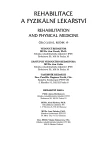Comparing the Effects of Various Forms of Regeneration after Load by Myotonometry
Authors:
P. Nováková 1; P. Šifta 2,3; Z. Pavelková 2; J. Judl 2; P. Dastych 1; E. Bahníková 3
Authors‘ workplace:
Katedra zdravotní TV a tělovýchovného lékařství FTVS UK, Praha
vedoucí katedry doc. PhDr. B. Hošková, CSc.
1; Katedra anatomie a biomechaniky FTVS UK, Praha
vedoucí katedry doc., CSc.
2; Katedra tělesné výchovy PF TU, Liberec
vedoucí katedry PaedDr. J. Martinec
3
Published in:
Rehabil. fyz. Lék., 19, 2012, No. 3, pp. 144-148.
Category:
Original Papers
Overview
The goal:
Objectification and comparison of efficiency of regeneration procedures to viscous and elastic properties of muscle tissue soleus muscle and gastrocnemic muscle after aerobic load
Hypothesis:
We assume that the most efficient method is stretching and massage. This statement is based on experience and frequency of use of different regeneration methods.
Methods:
Comparison of results of experimental studies done in the Czech Republic at Charles University, Faculty of Physical Education and Sport. Students who are active in sport taken apart in these studies and pick up method of objectification of viscous and elastic properties was chosen myotonometry.
Results:
As the most efficient form of decreasing muscle tonus shows application of dry needle.
Key words:
muscle tonus, regeneration, myotonometer
Sources
1. BAHNÍKOVÁ, E. Stanovení optimální regenerační metody po aerobní zátěži na základě myotonometrie. Bakalářská práce, Liberec, TUL, 2011.
2. DASTYCH, P.: Vliv sauny na svalový tonus po fyzické zátěži. Diplomová práce, Praha, FTVS UK, 2011.
3. ERNST, E.: Musculoskeletal conditions and comlplementary/alternative medicine. Best Practice and Research Clinical Rheumatology, 2004, č. 18, s. 539-556.
4. FURLAN, A., VAN TULDER, M., CHERKIN, D. at al.: Acupuncture and dry needling for low back pain: an updated systematic review within the framework of the Cochrane Colaboration. Spine, 2005, č. 30, s. 944-963.
5. HELLER, J.: Laboratory manual for human and exercise physiology. Prague, Karolinum, 2005.
6. JUDL, J.: Souvislost mezi výskytem trigger pointu v m. soleus a funkční poruchou SI skloubení a možnosti jejich vzájemného ovlivnění. Diplomová práce, Praha, FTVS UK, 2011.
7. NADLER, S. F., WEINGAND, K. W., KRUSE, R. J.: The physiologic basis and clinical applications of cryotherapy and thermotherapy for the pain practitioner. Pain Physician, 2004, č. 7, s. 395-399.
8. NADLER, S. F., WEINGAND, K. W., STITIK, T. P. et al.: Pain relief runs hot and cold. Biomechanice, 2001, č. 8, s. 1.
9. NOVÁKOVÁ, P.: Vliv masáže a pasivního odpočinku na zotavení svalu po aplikované zátěži. Dizertační práce, Praha, FTVS UK, 2009.
10. NOVÁKOVÁ, P., ŠIFTA, P., BITTNER, V., SÄCKLOVÁ, M.: Je masáž skutečně tak účinná, jak se předpokládá?. Rehabil. fyz. Lék., roč. 16, 2009, č. 1, s. 21-25.
11. PAVELKOVÁ, Z.: Snížení svalového napětí musculus soleus a gastrocnemius caput mediale po běžeckém výkonu. Bakalářská práce, Praha, FTVS UK, 2010.
12. ŠIFTA, P.: Poslední poznatky v teorii spoušťových bodů - trigger points. Kontakt, 2007, č. 2, s. 387-390.
13. ŚIFTA, P.: Měření viskoelastických vlastností měkkých tkání při spastickém syndromu. Dizertační práce, Praha, FTVS UK, 2005.
14. ŠIFTA, P., OTÁHAL, S., SüSSOVÁ, J., JAEGER, M.: Measurement of viscoelastic properties of soft tissue in spastic syndrome. Neurorehabilitation and Neural. Repair, roč. 22, 2008, č. 5, s. 545.
15. ŠIFTA, P., SÜSSOVÁ, J. A.: New method for measuring stiffness of soft tissue. International Journal of Rehabilitation Research, 2009. č. 1. s. 35.
16. ŠIFTA, P., BITTNER, V.: Measurement of reologic properties of soft tissue (Muscle Tissue) by device called myotonometer. IFMBE Proceedings, 2010, č. 31, s. 1020.
17. TOBIASOVÁ, M., SULLIVAN, J. P.: Strečink. Praha, Ikar, 1999.
18. TRAVELL, J. G., SIMONS, D. G.: Myofascial pain and dysfunction – the trigger point manual. USA, Lippincott Williams Williams, 1999.
19. WEERAPONG, P. HUME, P. A. KOLT, G. S.: The mechanisms of massage and effects on performance, muscle recovery and injury prevention. Sport. Med., roč. 35, 2005, č. 3, s. 235-256.
Labels
Physiotherapist, university degree Rehabilitation Sports medicineArticle was published in
Rehabilitation & Physical Medicine

2012 Issue 3
- Hope Awakens with Early Diagnosis of Parkinson's Disease Based on Skin Odor
- Deep stimulation of the globus pallidus improved clinical symptoms in a patient with refractory parkinsonism and genetic mutation
Most read in this issue
- Sulfane as a New Gaseous Hormone – Importance for the RFM Branch
- Coordination Dynamic Therapy Applied in the Syndrome of Painful Shoulder
- Changes in the Leg Locomotion at the Adult and Old Age in Comparison of Standing Position and Walking
- Shiatsu in the Physiotherapy Context
